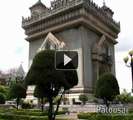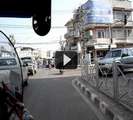Vientiane food market in Laos
The great Laotian epic, the Phra Lak Phra Lam, claims that Prince Thattaradtha founded the city when he left the legendary Lao kingdom of Muong Inthapatha Maha Nakhone because he was denied the throne in favor of his younger brother. Thattaradtha founded a city called Maha Thani Si Phan Phao on the western banks of the Mekong River; this city was said to have later become today's Udon Thani, Thailand. One day, a seven-headed Naga told Thattaradtha to start a new city on the eastern bank of the river opposite Maha Thani Si Phan Phao. The prince called this city Chanthabuly Si Sattanakhanahud; which was said to be the predecessor of modern Vientiane.
Contrary to the Phra Lak Phra Ram, most historians believe Vientiane was an early Khmer settlement centered around a Hindu temple, which the Pha That Luang would later replace. In the 11th and 12th centuries, the time when the Lao and Thai people are believed to have entered Southeast Asia from Southern China, the few remaining Khmers in the area were either killed, removed, or assimilated into the Lao civilization, which would soon overtake the area.
In 1354, when Fa Ngum founded the kingdom of Lan Xang, Vientiane became an important administrative city, even though it was not made the capital. King Setthathirath officially established it as the capital of Lan Xang in 1563, to avoid Burmese invasion. When Lan Xang fell apart in 1707, it became an independent Kingdom of Vientiane. In 1779, it was conquered by the Siamese general Phraya Chakri and made a vassal of Siam.
When King Anouvong raised an unsuccessful rebellion, it was obliterated by Siamese armies in 1827. The city was burned to the ground and was looted of nearly all Laotian artifacts, including Buddha statues and people. Vientiane was in great disrepair, depopulated and disappearing into the forest, when the French arrived. It eventually passed to French rule in 1893. It became the capital of the French protectorate of Laos in 1899. The French rebuilt the city and rebuilt or repaired Buddhist temples such as Pha That Luang, Haw Phra Kaew, and left many colonial buildings behind.
During World War II, Vientiane fell with little resistance and was occupied by Japanese forces, under the command of Sako Masanori. On 9 March 1945 French paratroopers arrived, and "liberated" the city on April 24, 1945.
As the Laotian Civil War broke out between the Royal Lao Government and the Pathet Lao, Vientiane became unstable. In August 1960, Kong Le seized the capital and insisted that Souvanna Phouma, become Prime Minister. In mid-December, General Phoumi then seized the capital, overthrew the Phouma Government, and installed Boun Oum as Prime Minister. In mid-1975, Pathet Lao troops moved towards the city and American personnel began evacuating the capital. On August 23, 1975, a contingent of 50 Pathet Lao women, symbolically "liberated" the city.
Vientiane was the host of the incident free 2009 Southeast Asian Games, with 18 competitions being dropped from the previous games held in Thailand, due to Laos' landlocked state and the lack of adequate facilities in Vientiane.
![]()





No comments:
Post a Comment